Disrupting for Good: AI, ...
Online Conference
28 Jan 2026 / 29 Jan 2026 read more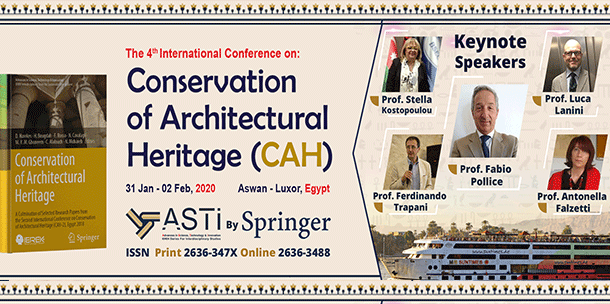

Prof. Stella Kostopoulou
Associate Professor of Regional and Tourism Development, Aristotle University of Thessaloniki (AUTh), Greece.
Antonella Versaci
Assistant professor at the Faculty of Engineering and Architecture, University "KORE", Enna, Italy.
Hocine Bougdah
Research and Education Consultant, IERS-UK / Visiting Lecturer, University of Westminster, London, UK.
Natsuko Akagawa
Senior Lecturer at the School of Languages and Cultures, Faculty of Humanities and Social Sciences, University of Queensland, Australia.
Subscribe to our newsletter
Overview of CAH- 4th edition:
The 4th International Conference on Conservation of Architectural Heritage was held onboard of Nile Cruise, sailing between Luxor and Aswan for 4 days/3 nights.
Chaired by Professor Stella Kostopoulou (Associate Professor of Regional and Tourism Development, Aristotle University of Thessaloniki (AUTh), Greece.) and organized by IEREK, it encompassed sightseeing trips to historical, cultural, and architectural sites.
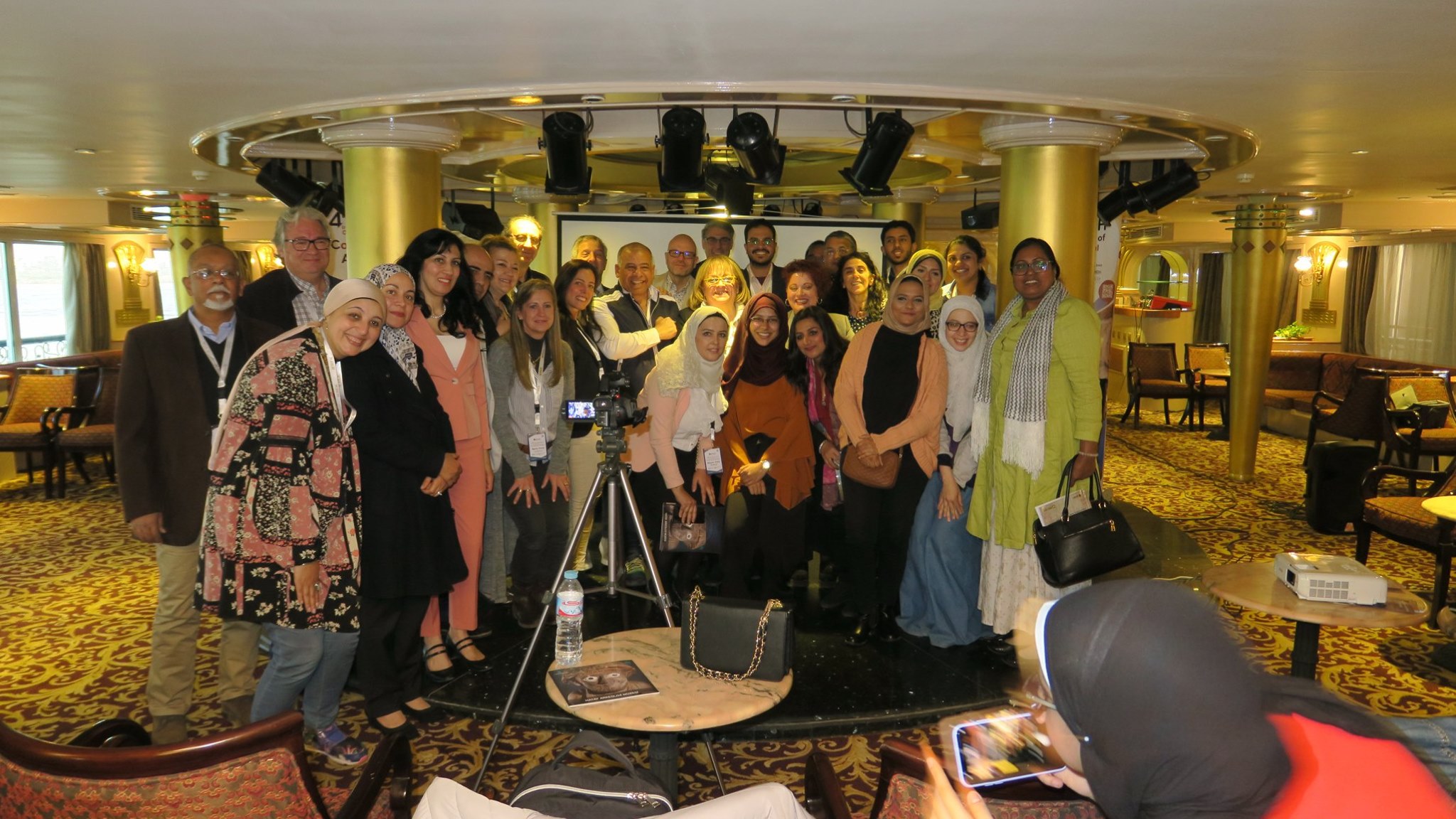
Day 1:
After arrival and lunch on board of the cruise, the attendees departed for a sightseeing trip to the High Dam followed by one to the Philae temple.
The opening session was held on the cruise after the participant’s return from the morning visits. It was opened by a welcoming word from the CEO of IEREK, Prof. Stella Kostopoulou and then a keynote speech delivered by Prof Fabio Pollice, Rector & Full Professor of Economic-Political Geography/ Director of the Department of History, Society and Human Studies at the University of Salento, Lecce, Italy, titled “Cultural Heritage for development: The local community perspective”.
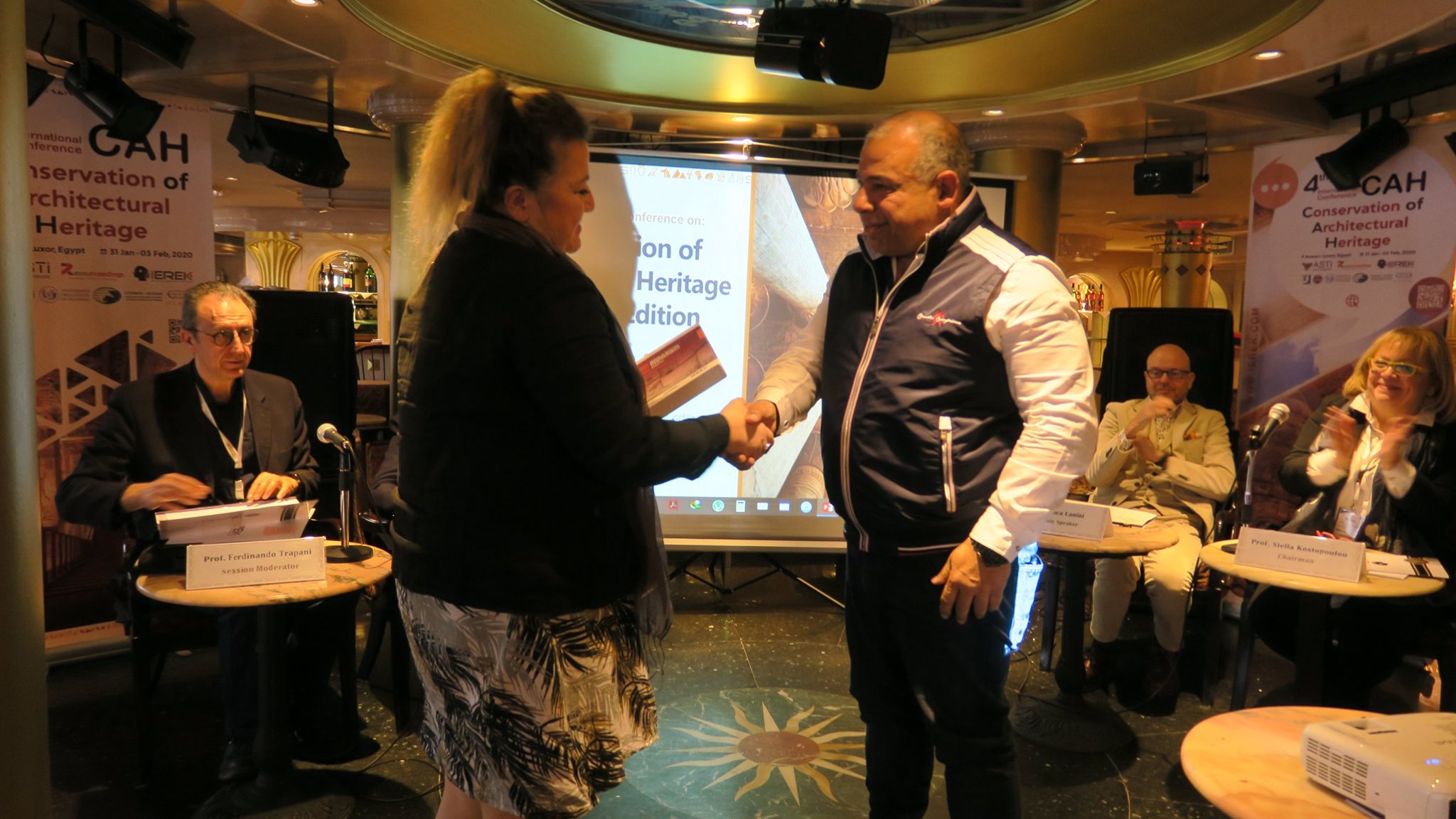
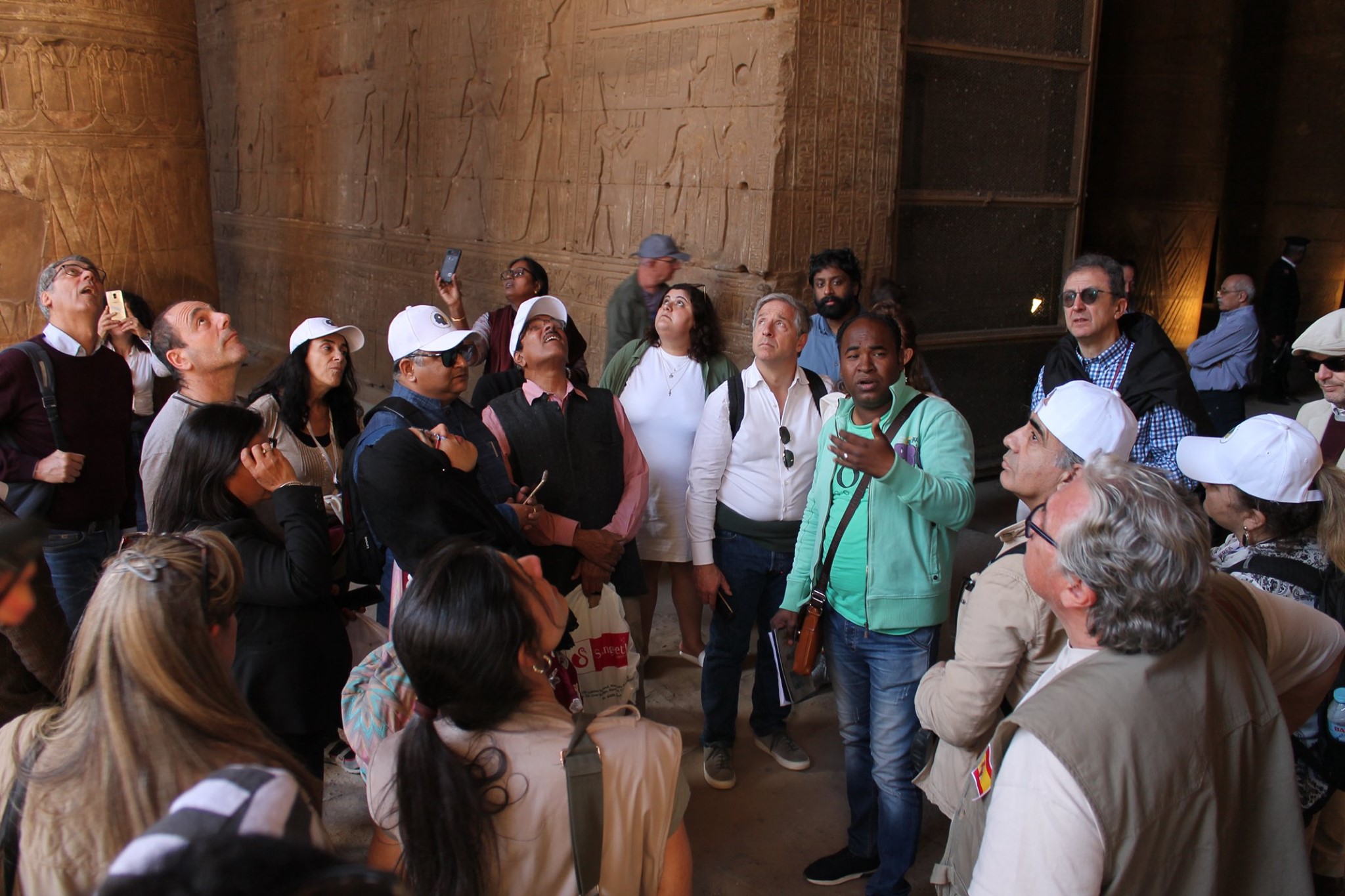
Day 2:
While sailing to “Kom Ombo”, the second day started with a keynote speech by Prof. Ferdinando Trapani, Associate Professor in Urban Planning at the Department of Architecture, University of Palermo, Palermo, Italy, titled “Erice: from conservation to revitalisation”.
The following speech of the day was delivered by Prof. Luca Lanini, Associate Professor, Department of Energy, Systems, Land and Construction Engineering, University of Pisa, Italy, entitled “Where it was, not how it was. Notes on Italian culture of restoration on modern architecture”.
The first session of the conference entitled “Importance of Architectural Heritage Conservation” was moderated by prof. Fabio Pollice and had 8 presentations concerning diversified case studies from around the world.
A Lunch and afternoon tea on the Sun Deck followed, after which a visit to “Kom Ombo Temple”, built during the Graeco-Roman period (332 BC AD 395), took place before another sail to “Edfu”.
After Dinner, the second session of the conference on “Identification of Architectural Heritage Conservation” was launched and moderated by prof. Ferdinando Trapani and Prof. Luca Lanini, followed by the third session titled “Management and Conservation of Architectural Heritage” which was moderated by Prof. Stella Kostopoulou and Prof. Ferdinando Trapani encompassing 10 presentations.
Day 3:
A visit to Edfu Temple, the second largest temple in Egypt and also known as the Temple of Horus, was a great start to the third and last day of the conference.
After the visit and a sail to Luxor, session 4 entitled “Architectural Heritage Conservation Techniques” was moderated by prof. Luca Lanini followed by session 5 on “Advancing Technologies and Innovation to Conserve the Architectural Heritage” which was moderated by Prof. Stella Kostopoulou and Prof. Ferdinando Trapani.
A visit to Luxor Temple which sits at the heart of Luxor in the east bank of the Nile River set a buffer for the day. Built by the pharoah Amenhotep III (1390-1352 BC), its walls are decorated with some of the finest carvings in Egypt which has remained in good shape as much of the temple was buried until 1885.
Another visit to the Karnak Temple, on the east bank of the Nile River, followed which consisted of an extraordinary complex of sanctuaries, pylons and obelisks dedicated to the Theban triad but also to the greater glory of pharaohs. This main structure is surrounded by the houses of Amun’s wife, Mut, and their son, Khonsu.
A closing ceremony, a final panel discussion, and an exchange of remarks and recommendations between the authors and the moderators concluded the conference. A Galabiya costume party wrapped up the night with some music and dance.
Day 4:
Day 4, known as check-out day, included a visit to Luxor’s West Bank where the Valley of the Kings, Queen Hatshepsut temple, and Colossi of Memnon are.
The Valley of the Kings is located on the west bank of the Nile River near Luxor, it’s the most well-known site for excavations of unique antiquities and ancient remains. Building Tombs was part of the ancient Egyptians’ beliefs of the afterlife and their preparations for the next world. They believed in the afterlife where they were promised to continue their lives and Pharaohs were promised to ally with the gods.
Hatshepsut’s Temples (the unique multi-tiered structure) is nestled up against the limestone cliffs at the shoulder of the river valley, a truly stunning sight. The site was used as a monastery during the early centuries. Hatshepsut’s status as the only female to rule Egypt is not the only reason for her fame but she was also a very successful pharaoh. She ruled over an era of peace, prosperity and expanded lucrative trade routes.
For a review of CAH 2020 – the 4th Edition published as part of the October-November 2020, Issue 80 of “News in Conservation”, read:
ISSUU: https://issuu.com/nic_iiconservation/docs/nic-oct-nov-2020_issue_80_issuu
PDF: https://www.iiconservation.org/system/files/publications/journal/2020/b2020_5.pdf
As we all know, conservation of architectural heritage is the process of restoring, conserving and managing changes of a heritage in a manner that sustains and enhances its significance, when possible. Conserving and keeping the architectural elements means maintaining; hence, increasing the buildings' values. Considering this, when restoration is possible it is favored to restore the buildings rather than replacing them.
Conservation of an architectural heritage site or building plays a vital role in defining the landmark as well as generating economic return and supporting the tourism industry. It also provides a sense of identity and continuity, in a fast-changing world, for the future generations.
Preserving the architectural heritage provides concrete benefits to property owners, businesses owners and to the community as a whole because re-using existing fabric means requiring fewer new materials and more labor-intensive work by local trades. It also increases property value for both the restored buildings and surrounding properties. Additionally, conservation of the architectural heritage uses less than half of the energy used in the construction of new buildings whilst reducing the construction waste.
In this regard, IEREK organizes the 4th international conference on Conservation of Architectural Heritage (CAH), which will be held on a Nile cruise sailing from Aswan to Luxor. The conference aims to discuss the potential of architectural heritage conservation in acting as a catalyst for regeneration in areas like tourism and economic development, which in turn helps businesses attract customers. It also discusses the stimulus it can produce in order to inspire new development of imaginative and high-quality design.
The conference will definitely be a great opportunity for planners, engineers and environmentalists to work together and help conserve the architecture and heritage of a city. It will be a platform to discuss the challenges that can be faced during the process of conserving the architectural heritage. It will also help provide them with the chance to enlighten the individuals & communities on the importance of heritage preservation to .
Selected papers of the conference will be published, by Springer, in a book series under the title of Advances in Science, Technology, & Innovation (ASTI).
1.1 History of Architectural Conservation
1.2 Utopian and Sacred Architecture
1.3 Nomad's Architecture and Desert Communities
1.4 Governance, Partnerships, and Communities of Practice
1.5 Awareness of Heritage Rehabilitation Projects
2.1 Understanding the Significance of Cultural Heritage Conservation
2.2 Ways to Conserve the Architectural Heritage
2.3 Conserving the City's Tradition and Identity through the Protection of the Architectural Heritage
2.4 Effects of Architectural Heritage Conservation on Tourism Development and Urban Preservation
2.5 Socio-economics Impact and Environmental Benefits of Heritage Conservation
3.1 Protecting Architecture Ethnic Groups
3.2 Conservation of Cultural Memories through Interior Designs
3.3 Principles of Conservation of Archaeological Sites
3.4 Conservation and Development of Heritage Landscape Planning
3.5 Ecosystem Management and Conservation Strategies
4.1 Impact of Conservation of Architectural Heritage on the Environmental Protection
4.2 Materials Used in the Protection of the Heritage Sites
4.3 Challenges of Conserving the Architectural Heritage
4.4 Transshipping of Cultural Heritage and Identities to the Future Generations
4.5 Best Practices in Assessment, Designating, and Managing World Heritage
5.1 Mapping Archeological Sites Using Geographic information System (GIS)
5.2 Using Remote Sensing to Monitor the Changes within Heritage Sites
5.3 Using ultra-sounds and other rays in treatments of buildings and in the process of rehabilitation
5.4 New materials and methods of treatments for cracks
5.5 International case studies using technologies in conserving heritage buildings and sites
Attending conferences is very beneficial, especially, on the professional level; conferences are full of people promoting new ideas which will expand your knowledge and undoubtedly help your career.
Moreover, all conference papers are archived online in the E-Library of IEREK‘s website where they are immediately and permanently available to the international scientific community.
| Title | Date |
|---|---|
| Abstract Submissions Deadline | 30 Sep 2019 |
| Last Notification for Abstract Acceptance | 18 Oct 2019 |
| Full Paper Submission Deadline | 30 Nov 2019 |
| Last Notification for Full-Paper Acceptance | 28 Dec 2019 |
| Early Payment Deadline | 31 Oct 2019 |
| Regular Payment Deadline | 30 Nov 2019 |
| Late Payment Deadline | 03 Jan 2020 |
| Letter of Visa (for delegates who need visa entry) | 28 Dec 2019 |
| Letter of Final Acceptance | 28 Dec 2019 |
| Conference Program | 30 Dec 2019 |
| Conference Launch | 29 Jan 2020 |
Beau Soleil Nile cruise, Aswan City, Egypt.

Fabio Pollice has PhD in Political Geography from the University of Salento; he taught in the universities of Naples "Federico II" and Rome "La Sapienza".; he has been Director of the Department of History, Society and Studies on Human University of the Salento since March, 2016, after having been Coordinator of the Research Doctorate in Human and Social Sciences with the same University, for three years.
Prof. Fabio Pollice is also a member of the Board of Directors of the Italian Geographic Society (SGI) and National Coordinator of Regional Trustees; member of the Scientific Committee of the European University Center for Cultural Heritage (CUEBC), of EURISPES and of the "La Notte della Taranta" Foundation.

Stella Kostopoulou has also taught under- and postgraduate courses at Cyprus University of Technology, Hellenic Open University, International Hellenic University, Democritus University of Thrace, and University of Thessaly. She also gave lectures at Universities and International Organisations abroad (Peking University, La Trobe University, York University, Moscow State University of International Relations, OTIE-Observatory on Tourism).
Prof. Stella Kostopoulou has published on regional economics and planning, tourism, cultural industries and local development in international scientific journals e.g. Sustainability, Anatolia: An International Journal of Tourism and Hospitality Research, International Journal of Sustainable Development.

Antonella Falzetti is a research PhD at the Department of Civil Engineering at Tor Vergata University of Rome, in Architecture and Building, with a thesis entitled “La Chiesa Dio Padre Misericordioso by Richard Meier, design and construction”.
She has also been responsible for the structure and management of the Architectural and Urban Design Laboratory (research and third mission) at the DICII since 2014, at the Tor Vergata University of Rome.
She was awarded in 2008 with the 1st place prize, as part of the design group for the final and executive design and study of environmental impact and landscape report, for the realization of the Campus of Science, Technique and Environment in Selargius (INAF).

Ferdinando Trapani is in charge of the Department of Architecture to several EU projects and the scientific cooperation co-financed by the Structural Funds of EU with local & regional authorities, in the place-based policies into spatial planning practices. He represents the Architecture Department of University of Palermo of the Territorial Living Labs in Sicily for Social Innovation.
Prof. Ferdinando Trapani is a member of the Italian Institute of National Urban Planning: ‘Istituto Nazionale di Urbanistica’; collaborated with the National Commission for Infrastructural Policies from 2010 until 2014. He is also a vice president of Istituto di Ricerca e Promozione delle Aree Interne della Sicilia, Caltanissetta (Italy).

Prof. Luca Lanini teaches Architectural Design at the DESTeC. Among his best titles: Vázquez Consuegra (Edilstampa 2008), BEAR Luca Lanini / Manuela Raitano-Progetti (Libria 2012), Modern architecture; Le Corbusier, Mies van der Rohe, Terragni, Niemeyer (Ediesse 2014); a critical edition of L. Zuccoli, Fifteen years of life and work with his friend and teacher Giuseppe Terragni (Libria 2015); The architecture of the modern villa. 1900-1940 The years of great experimentation (Quodlibet 2016), The city of steel. Constructivist Moscow 1917-1918 (Pisa University Press 2017), SH-New Perspectives in Social Housing (Pisa University Press 2017), Rise and Fall of Ivan Leonidov (Clean 2018).
– Instructions
– IEREK is happy to invite students from everywhere to register for and attend as an audience in the Conservation of Architectural Heritage Conference For FREE (accommodation fees are not included ) only until the 30th of November, 2019. This is an opportunity to enjoy the process of learning through new experiences and gaining knowledge.
– This is your chance to not only get to see some of the world’s and Egypt’s most famous antiquities and archaeological sites but also to meet respectable and famous academics in their fields. Kindly note that this offer does not include accommodation.
Register now for accommodation!
Loyalty Membership Discounts
The more you attend, the more you're rewarded!
IEREK offers its loyal participants with the following discounts depending on his/her attendance:
| Attendance | Second | Third | Fourth | Fifth |
|---|---|---|---|---|
| Discount | 5% | 10% | 15% | 20% |
*The aforementioned discounts are only applicable during Regular and Late Payment times. For more information, please refer to 'Important Dates'.
Author Fees (for Short Paper)
| Author fees for Early Payment | 02 Nov 2019 | USD 250 |
|---|---|---|
| Author fees for Regular Payment | 02 Dec 2019 | USD 300 |
| Author fees for Late Payment | 01 Jan 2020 | USD 400 |
Author Fees (for Long Paper)
| Author fees for Early Payment | 02 Nov 2019 | USD 400 |
|---|---|---|
| Author fees for Regular Payment | 02 Dec 2019 | USD 500 |
| Author fees for Late Payment | 01 Jan 2020 | USD 600 |
Regular Attendance Fees
| Fees for Audience (Co-authors, Learners, and Interests) | USD 250 |
|---|---|
| Fees for NON-Attending Co-Authors | USD 50 |
Extra Fees (upon request)
|
Additional Conference Book (Hard copy + CD) * In addition to 1 free copy gifted to main authors, additional copies are available for the fee mentioned. |
USD 100 |
|---|---|
|
Springer/Journal Publication (Extended Paper) * In cases of selection/consideration for publication, short papers must be extended and the additional payment, for extension, completed. |
USD 200 |
Author Fees (for Short Paper)
| Author fees for Early Payment | 02 Nov 2019 | EGY 2000 |
|---|---|---|
| Author fees for Regular Payment | 02 Dec 2019 | EGY 2500 |
| Author fees for Late Payment | 01 Jan 2020 | EGY 3000 |
Author Fees (for Long Paper)
| Author fees for Early Payment | 02 Nov 2019 | EGY 3300 |
|---|---|---|
| Author fees for Regular Payment | 02 Dec 2019 | EGY 3800 |
| Author fees for Late Payment | 01 Jan 2020 | EGY 4800 |
Regular Attendance Fees
| Fees for Audience (Co-authors, Learners, and Interests) | EGY 1500 |
|---|---|
| Fees for NON-Attending Co-Authors | EGY 500 |
Extra Fees (upon request)
|
Additional Conference Book (Hard copy + CD) * In addition to 1 free copy gifted to main authors, additional copies are available for the fee mentioned. |
EGY 600 |
|---|
Delegates in any event who cancel their registration due to special circumstances will receive refunds according to the following plan:
| Cancellation Policy | Up to 60 days before the event | Up to 50 days before the event | Up to 40 days before the event | 39 days before the event |
| Penalty | 20% | 50% | 70% | 100% |
EXCEPTION
A refund is not possible if
-An acceptance letter has been issued (Authors only)
-The proceedings of the event have been published (Authors only)
-All matters have been finalized (accommodation/travel expenses paid for)
Visa Rejection Cases
Reason and proof of rejection must be submitted. If the reason for rejection is due to an error on our part, the participant will be refunded their full fee with a deduction of a 20% administration fee.
Documents to be issued by IEREK to acquire a visa are as follows:
*Final Acceptance Letter (Authors only)
*Visa Invitation Letter
*Invoice/proof of payment
We encourage all authors and attendees to ensure their having acquired all documents (those applicable) mentioned.
If the reason for rejection is not related to any of the aforementioned and is an error on the participant’s part, the following will apply:
*Authors: may choose to let their co-author present his/her research on his/her behalf free of charge. If the author does not have a co-author, a member of the scientific committee shall present on the author’s behalf.
*Audience members/Registrants: will only be allowed to attend another similar event of their choosing that is organized by IEREK free of charge.
All accepted papers of the fourth Conservation of Architectural Heritage (4th CAH) after the peer-review process will be either published as chapters in the Book Series “Advances in Science, Technology and Innovation” (ASTI) by Springer or in The International Journal of Proceedings of Science and Technology (Resourceedings) online by IEREK Press.

The ASTI Book Series by Springer is by highly professional members of an International Editorial Board to ensure a high-quality publication material to be eventually published online and printable.
The ASTI Book Series will be submitted for indexation in Web of Science (ISI), EI-Compendex, and Scopus databases.
To publish your research in the online Journal or Book by 'Springer' and provide it with world-wide visibility, authors must submit an extended version of their short papers that are 10 -12 pages long.
If you are not sure whether you or one of your co-authors will be able to attend the conference, you should bear in mind that there is a fee to be paid for Audiences (Co-authors, Learners, and Interests). The accepted paper will not be included in the conference proceedings without paying the fee (see Conference Fees for more details). A research paper fee allows only one author, whether main or co-author, to attend the conference and receive only one copy of the conference proceedings book in both hard and soft copies. Extras can be requested for a fee shown below.
The proceedings of the Conservation of Architectural Heritage (4th CAH) will consist of 5 sections (or Parts), each edited by the following group of Chief Editors:
Antonella Versaci
Assistant Professor at the Faculty of Engineering and Architecture, University of Enna "KORE", Enna, Italy.
Hocine Bougdah
Research and Education Consultant, IERS-UK / Visiting Lecturer, University of Westminster, London, UK.
Natsuko Akagawa
Senior Lecturer at the School of Languages and Cultures, Faculty of Humanities and Social Sciences, University of Queensland, Australia.

Hocine Bougdah is a Reader in Architectural Technology; the Canterbury School of Architecture, University for the Creative Arts, Canterbury, UK.
Dr Hocine Bougdah is a reader and subject area leader for Technology and the Environment in the School of Architecture. He has overall responsibility for the curriculum design, delivery and assessment of the Architectural Technology subject specialism in the school at both undergraduate and post-graduate levels. He is also involved in research through the supervision of a number of researchers (currently 6) working on topics aligned with his research interests.
Dr Bougdah’s teaching and research interests are focused on the technological, ecological and human aspects of architectural design. His approach to teaching “Technology” is to use it as a design generator/enabler rather than an “add-on” technical resolution to a design proposal. His research interests cover topics such as sustainable design, innovative low tech/low energy/low impact buildings, spatial experience of users and issues of culture, urbanisation and globalisation. Alongside his academic role, he runs a design/consultancy practice

Antonella Versaci is a researcher and assistant professor at the Faculty of Engineering and Architecture, University “Kore” of Enna, where she is responsible of the “Laboratory of Restoration of Architectural and Cultural Heritage” and teaches “architectural restoration” and “laboratory of architectural restoration” within the Master of Architecture.
She is also an associate researcher at the Institut Parisien de Recherche Architecture Urbanistique Société (IPRAUS), a research laboratory of the ENSAPB – National Superior School of Architecture of Paris-Belleville (UMR 3329 Ausser).
Her research applies to the issues of safeguarding and conservation of historic buildings and landscape, with particular attention to cultural heritage spread across the territory and to the protection of historic centers, as well as to their survey, diagnosis, classification and valorization.
In 1996, she earned a master’s degree in Building Engineering at the University of Messina and, the following year, obtained a scholarship for postgraduate specialization courses abroad.
She then attended in Paris two courses of specialization in urban preservation, strategic planning and management earning both degrees. In 2005, she received a PhD degree cum laude in “Architecture” from the University of Paris VIII, with a dissertation on the legislation on historic centers in France.
From June 2004 to September 2008, she was a UNESCO International staff member, responsible for numerous cultural projects in Southeastern Europe, including those related to the creation of a School of Restoration in Tirana (Albania) and to a Center for Digitization of heritage cultural in Skopje (FYROM).

Dr Natsuko Akagawa is tenured at The University of Queensland. She is the author of Heritage conservation in Japan’s cultural diplomacy: Heritage, national identity and national interest (Routledge 2014), the seminal work theorising Heritage and Cultural Diplomacy. She is a co-editor of Safeguarding Intangible Heritage (Routledge 2019) and Intangible Heritage (Routledge 2009), internationally influential studies on Intangible Heritage. She is the Expert Member for International Council on Monuments and Sites (ICOMOS) and member of the International Council of Museums (ICOM).
For IEREK's Provious Publications, Please Click here
- Conservation of Architectural Heritage (CAH) held on a Nile cruise from Luxor to Aswan in November, 2015.

- Conservation of Architectural Heritage (CAH) -2nd Edition held on a Nile cruise from Aswan to Luxor in February, 2018.


- Conservation of Architectural Heritage (CAH) -3rd Edition held at the Nubian Museum, Aswan in February, 2019.


Elementary Review:
Once an abstract has been submitted to our website, it is assigned for review by the reviewers using the abstract review sheet and validation of publication. This is based on four criteria:
· Accepted for publication (with minor editing changes).
· Conditionally accepted for publication (with revisions provided to authors).
· Rejected but encouraged for re-submission with major modifications.
· Rejected as inappropriate or unworthy of publication in this certain conference.
The criteria for accepting abstracts for the conference are as follows; a relevant topic of the conference should be proposed with clear writing, aims, and objectives of the study clearly presented as well as a sound literature and methodology of work.
First Acceptance:
Authors will receive a notification message to know the feedback of the reviewers' committee. If an author receives the acceptance of his or her abstract, he or she has to continue writing the full-length paper using the requested templates.
Uploading Full-Length Paper:
Authors who are allowed to upload their full-length paper(s) should use the same account details to upload their full paper(s).
Second Acceptance:
The final paper will proceed to the primary revision to be checked if it meets the conference proceedings standards. Once it gets accepted, the author will be informed to pay the fees so that it could be sent for the final revision by the scientific committee.
Payment:
In this step, and to proceed paper(s) that passed to final revision process and to get the final approval, authors have to pay the requested fees. Otherwise, the final revision process will not be considered for their papers.
Inspections and Final Approval of Full Papers:
The full papers that paid the requested fees will get finally inspected, either scientifically or linguistically. There will be a rigorous review process of full papers following the previous process according to the following criteria:
(1) Is the topic relevant to the conference?
(2) Are the writing and structure clear?
(3) Are graphics, photos, illustrations used where needed?
(4) Are the aims of the study clearly stated?
(5) Are the objectives of the study achieved?
(6) Is the literature review relevant and adequate?
(7) Has the author used the appropriate methodology and explained them clearly?
(8) Has the author interpreted the findings correctly?
(9) Is the paper a significant contribution to the field?
These are the registration and revision procedures for publication that all authors should follow.
Authors are respectfully requested to abide by the following steps/instructions in order to participate in the international conference of "Conservation Of Architectural Heritage (CAH) 4th Edition" and get their papers published...
Step 1: Abstract Submission
- Author (researcher) should submit an abstract file (paper summary) through our online system before the abstract submission deadline.
- Submitted abstract should not exceed 300 words.
- The abstract should clearly state the purpose, results, and conclusions of the work to be described in the final paper.
- You should the most relevant topic to your paper from the conference topics.
- Abstract file should include the author's full name, email address, academic title and affiliation.
- Abstract file should include Co-authors' full name, email address, academic title and affiliation. (if exist)
- The author can use/download abstract writing template to submit the abstract file accordingly (please download from the link provided below).
Step 2: Abstract Review
- Once abstract is submitted abiding the mentioned instructions, it will be sent to undergo revision process by members of our scientific committee, the author will receive abstract feedback and next step action by email within 2 weeks maximum from abstract submission date.
- Once the abstract is accepted, the author will receive abstract acceptance notification by email stating that the abstract is accepted and to proceed with full/short paper submission.
Step 3: Paper Submission
- The author should submit the full/short paper written on the writing template, through our online system before the paper submission deadline (please download the writing template from the link provided below).
- The full/short paper should be written in English as it's the official language of the conference "Conservation of Architectural Heritage (CAH) 4th Edition".
- The full paper file shouldn't exceed 12 pages while short paper shouldn't exceed 5 pages.
- The full paper should state the major issue(s) addressed, the potential significance of the work, the theoretical and methodological approach(es) pursued, major findings, conclusions, implications, and relevant scholarly references.
- The short paper should clearly mention the major issue(s), methodological approach(es), major findings, conclusions, and relevant scholarly references.
- The full/short paper must be relevant to the conference theme and must be original as we don't accept research papers with similarity rate of more than 20%.
Step 4: Paper Elementary Review
- Once the full/short paper is submitted abiding the mentioned instructions, it is assigned for review by the reviewers of scientific committee in aligning with IEREK revision SOP (double-blind process).
- The author will receive paper feedback and next step action by email within 1-month maximum from paper submission date.
Step 5: Payment
- Once the paper gets accepted, the author will be informed to pay the conference fees so that it could be sent to another 2 members of the scientific committee in order to provide the author with comments/notes that could improve the paper and push it to the limits.
- As soon as payment is confirmed and done successfully, corresponding official documents can be issued from our side such as paper acceptance letter and invitation letter.
Step 6: Paper Final Review
- The paper will be sent for review by another 2 members of the scientific committee in aligning with IEREK revision SOP (double-blind process). Reviewers' comments/notes will be forwarded to the author in order to modify the full paper accordingly. Then, send us the final version of the paper.
Downloads
Instructions of Short Paper Submissions:
Authors who would like to submit short papers should be informed that the structure of a short paper should contain its abstract, keywords, introduction, problem statements and the hypothetical solution along with further studies that they will go through when they want to extend their paper to be published online. A short paper fee doesn’t have a chance to receive any type of discount whether the author was previously published with IEREK or is one of IEREK’s scientific committee or a representative of a co- host university. A short paper is only published in the conference proceedings book and will not have a chance to be published online by Springer or by IEREK’s Journals unless the author extends their work to a full length paper and pay the requested fee.
Short Papers
To download the writing template for a Short paper,Click hereTo download the writing template for a full-length paper,Click here
Abstract and full paper submission instructions,Click here
- IEREK has an unyielding policy regarding plagiarism. We believe that copying/taking the ideas and work of other Authors without permission and credit is fraudulent.
- The Reviewing committee and IEREK employees have the authority to reject a paper during its reviewing process, on the basis of the paper being subjected to either minor or major plagiarism.
- Duplicating any content, even if it is one sentence or one table without the consent of its original Author, will lead to the paper’s refusal upon the complaint of the plagiarism victim.
- For participants who need Entry Visas to the country where the conference will be held, IEREK will issue the corresponding invitation letter for accepted applicants to facilitate visa issuance.
- Please notice that we will endeavor to assist you in obtaining a visa but the responsibility is yours and the decision rests solely with the appropriate Embassy.
Invitation Letter Issuance Process
1- In case the participant is an author who has submitted a research paper to the conference, it must get accepted by the Scientific Committee
2- Required participation fees must be paid
3- The participant should send the following information to the conference's official email:
* A clear copy of passport
* Passport number
* Full name as written in your passport.
* Date of Issuing and Expiration
* Date of Birth
* Email address of the nearest Portugal Embassy/Consulate to you
* Mobile Number including country code
4- Conference coordinator will issue the needful invitation letter and send a copy to the participant's email, in addition to another one to the corresponding email address of embassy/consulate
5- The participant should print out the invitation letter along with all other required documents by the embassy/consulate and apply for VISA
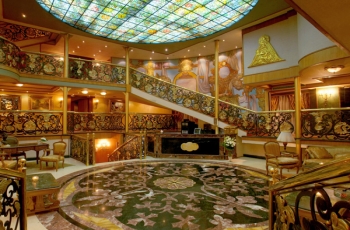 |
 |
 |
 |
 |
 |
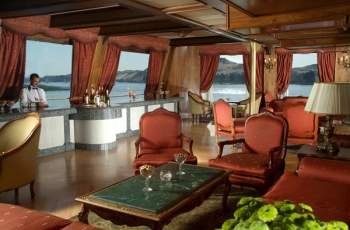 |
 |
Kindly, note that the number of single rooms available is very limited.
The policy of “First Paid, First Served” will be followed!
Before the 2nd of December
| 3 Nights for single occupancy in a Double Room | $290 |
| 3 Nights Single Room | $440 |
After the 2nd of December
| 3 Nights for single occupancy in a Double Room | $390 |
| 3 Nights Single Room | $550 |
Before the 2nd of December
| 3 Nights for single occupancy in a Double Room | EGP 3000 |
| 3 Nights Single Room | EGP 4200 |
After the 2nd of December
| 3 Nights for single occupancy in a Double Room | EGP 3500 |
| 3 Nights Single Room | EGP 5000 |
Note: Upgrading from a double room to a single room is only possible if you pay the price difference.
The conference will be on the Nile cruiser starting from the city of Aswan and travelling up to Luxor, which will take a total of 3 days.
Aswan is still and will always be a must-see tourist destination in Egypt, famous for its beautiful scenery along the Nile and the Nubian culture that is still a strong influence in southern Egypt. In spite of the concentration of tourists in Luxor around its many pharaonic monuments, Aswan provides a much more relaxed experience. It is the smallest of Egypt’s major touristic cities, but it also bears the distinctive mark of the more relaxed Nubian culture. People interested in pharaonic history can’t pass up Aswan because of it's impressive toutist attraction sites like Philae Temple, Aswan High Dam, Abu Simbel Temples and the Nubian Village. Here are some of the most incredible things you can do in Aswan:
Nubian people are very friendly and hospitable. They often invite guests into their houses to have a cup of their traditional drink “Karkade”. The houses are painted with bright colors, with floors made of sand and some of the rooms have no roofs. Aswan is one of the driest places in the world so there is no need for protection against rain. Nubians are also famous for their traditional crafts which are often displayed, such as the unique “Shamsi” bread with a homegrown baking technique. You can visit Aswan’s Souq which is a colorful bazaar that is known as the cheapest place to buy souvenirs in Aswan. The bazaar has various Egyptian and African goods such as perfumes, peanuts, henna powder, spices and dried hibiscus flowers “Karkade”. There are also T-shirts and custom made Ancient Egyptian styled souvenirs. In side alleys, you can find traders selling Nubian artifacts such as skullcaps, talismans, baskets, Sudanese swords, carpets, and stuffed animals like crocodiles and much more.
In Aswan, you will have the opportunity to not only eat delicious home cooked Nubian food, but you will also learn the culture and history of its residents. Unfortunately, some have to move away from their old villages that were located near the Cornishe of Elephantine Island. Nubians used to live in the valley of the Nile south of Aswan, but in 1960, the High Dam construction caused flooding for many Nubian villages, so the Nubian had to relocate in Gharb Aswan near the Tomb of the Nobles.

The Philae Temple has an equally enchanting location, downstream of the Aswan Dam and Lake Nasser and mentioned by multiple ancient writers in their works. The island temple contains multiple ruins and rocks, inscribed with the names and titles of Amenhotep III, Ramesses II, Psamtik II, Apries, and Amasis II, together with memorials of the later Macedonian and Roman rulers of Egypt. It magnificently is a crossroad of the different eras in Egypt’s cultural and religious history.
Upon entrance, the First Pylon leads into the main temple area, where you can admire the huge relief depicting the Egyptian king Dionysos grasping a band of enemies by the hair and raising his club to smite them, with Gods Isis and Hathor on the left. A grand sight to witness indeed. One more interesting thing to note would be Napoleon’s inscription on the central doorway, commemorating his campaign in 1799. Within the main courtyard, make sure to check out the Birth House, where epic scenes from the childhood of Horus, including Horus as a falcon and Isis suckling Horus in the swamps, are inscribed. The entire Philae Temple contains endless ancient wonders and sculptures, not only limited to Ancient Egypt but also its Greco, Macedonian and even French links. The temple is an awe-inspiring sight to see, and cannot be missed!

Do visit the museum located on the island, where a mummified Ram of Khnum, one of Egypt’s earliest deities, is displayed. Artifacts dating back to pre-dynastic times have also been found on Elephantine and are showcased in the museum. Furthermore, the entire island is like an extended live museum in itself. The oldest ruins still standing on the island are a granite step pyramid from the third dynasty and a small shrine, built for the local sixth-dynasty monarch, Hekayib. A rare calendar, known as the Elephantine Calendar, and one of the oldest nilometers in Egypt, last reconstructed in Roman times, is also located on the island.
The Elephantine is the largest island in the Aswan archipelago. Located opposite the Corniche, the island derived its name from historic ivory trading. In Ancient Egyptian times, the island had a fort that stood at Egypt’s southern border with Nubia, making it an excellent defensive site for a city and a natural cargo transfer point for river trade. Elephantine was also an important stone quarry, providing granite materials that is transported widely within Egypt to be used in monuments and buildings. With such rich historical significance, the island is a must-visit for Ancient Egypt enthusiasts!
Do visit the museum located on the island, where a mummified Ram of Khnum, one of Egypt’s earliest deities, is displayed. Artifacts dating back to pre-dynastic times have also been found on Elephantine and are showcased in the museum. Furthermore, the entire island is like an extended live museum in itself. The oldest ruins still standing on the island are a granite step pyramid from the third dynasty and a small shrine, built for the local sixth-dynasty monarch, Hekayib. A rare calendar, known as the Elephantine Calendar, and one of the oldest nilometers in Egypt, last reconstructed in Roman times, is also located on the island.

The museum itself is also a work of art. Its architecture reflects the traditional character of the Nubian architecture, thereby winning the Agha-Khan Award of Architecture in 2001. You can also visit the beautiful garden in the museum, where there are waterfalls, palm trees, flowers, and climbing bushes, spread around natural rocks. There is also an amphitheatre for local and international music and dance performances.
The locale of Aswan originally belonged not to Ancient Egypt (before it was conquered), but to a kingdom known as Nubia or the “Land of Gold” in ancient times. The Nubian kingdom was located south of Ancient Egypt and as one of the indigenous peoples of the region, it had a rich history.
To preserve this crucial and ancient heritage, after the construction of Aswan’s High Dam, the Egyptian government appealed to the UNESCO, kick starting an immense international plan to excavate and record hundreds of sites. These precious materials were thereby preserved and showcased in a museum in Aswan to exhibit the unique Nubian heritage. Multiple temples on the island such as the ones at Abu Simbel and Philae were also disassembled and reconstructed on higher grounds.
Construction of the museum is a work of art. Its architecture reflects the traditional character of the Nubian architecture, thereby winning the Agha-Khan Award of Architecture in 2001. You can also visit the beautiful garden in the museum, where there are waterfalls, palm trees, flowers, and climbing bushes, spread around natural rocks. There is also an amphitheatre for local and international music and dance performances.

Thereby, the Aswan High Dam possesses extremely significant historical, political and environmental connotations, making it one of the most visited sites for those who come to Aswan. It has reshaped the city and up till today, plays an important role in the development of Egypt’s hydro-electricity sector and agriculture.
The creation of the Aswan High Dam and its counterpart, the man-made Lake Nasser, was a project that received much debate. Culturally, it destroyed many traditional Nubian villages and temples, while multiple artifacts were disturbed and had to be relocated, Temple of Abu Simbel was one of many.
Environmentally, the annual flood of the Nile which provided extremely fertile soil for farmers downstream which the dam stopped. This resulted in the need for fertilizers to grow crops, which the expense damaged the livelihoods of farmers. This controversy was intensified with construction of the dam being aided by the Soviets in the Cold War, where Nasser was trying to champion Arab nationalism in opposition to American influence in the region.
Thereby, the Aswan High Dam possesses extremely significant historical, political and environmental connotations, making it one of the most visited sites for those who come to Aswan. It has reshaped the city and up till today, plays an important role in the development of Egypt’s hydro-electricity sector and agriculture.

These temples are one of the world’s most incredible monuments, and Egypt’s second most visited touristic site, the Pyramids of Giza being on the top of the list. The temples were relocated in the 1960s and that was a historic event. At that time, the temples were threatened by submersion in Lake Nasser when the High Dam was constructed. Relocation of the Temples was successful and they were dismantled to a spot above the cliff where they had been built. The more famous of the two temples is dedicated to Ramses II and the smaller one to his favorite wife Nefertari. The Temples were built by Ramses II in the 13th century BC. The huge facade of Ramses II temple represents four colossal seated figures of Ramses. The facade is 119 feet wide, 100 feet wide and each statue is 67 feet high. Door of the facade leads to the interior of the temple which is a 185 feet long man-made rock cave leading to a series of halls and rooms. The most interesting feature about the Temple of Abu-Simbel is the oriented construction. The magical thing about the temples is that twice a year, the morning sun rays shine through the length of the inner temple cave and light up the statues of the four Gods at the end of the cave.

luxor city is known to be the greatest open-air museum in the world. It’s on the site of ancient Thebas, “ the Pharaohs” capital at the hight of their power on 16th century BC. The city lies between the east and west banks of the River which is crosssed daily by tourists and locals with Felucca boats and Ferries.
No place in the world compares to the grandeur and scale of the monuments which have survived from ancient Thebes (Luxor). The city is famous with many ancient monuments which can’t be missed. These sites are either located in the east bank of the Nile river like Luxor temple and Karnak Tample, or in the west bank like Tomb of the Nobles, The Valley of Kings and The Valley of Queens. The two grand temples of Luxor are the Luxor and Karnak Temples linked by the Avenue of Sphinx which has been recently renovated.
The Temple sits in the heart of Luxor in the east bank of the Nile River. It was built by the pharoah, Amenhotep III (1390-1352 BC). The walls are decorated with some of the finest carvings in Egypt and protected beacause much of the temple was buried until 1885.
The temple would have been surrounded in ancient times by warrens of mud-brick houses, shops and workshops but now lie under the modern town. In 1885, excavation works began which have cleared away the village and debris of centuries to uncover what we can see of the temple today. In front of the temple is the beginning of the Avenue of Sphinxes which ran all the way to the temples of Karnak (3 km to the north) and is now almost entirely uncovered.
The location of the temple makes it a very easy site to visit even when it’s not open to visitors, the temple is visible during a stroll down the Nile cornishe or through downtown Luxor.

The Karnak Temple, located on the east bank of the nile river, is an extraordinary complex of sanctuaries, pylons and obelisks dedicated to the Theban triad but also to the greater glory of pharaohs.
Its site covers more than 2 Km2 which is large enough to contain about 10 cathedrals. Contsruction of the Temple started around 4,000 years ago and continued up until around 2,000 years ago when the Romans took control of Egypt. Each Egyptian ruler made their own mark in the architectural work of the temple. The Karnak Temple was the most important place to worship in Egypt during the time of the New Kingdom. In the heart of the temple is the temple of Amun-Ra, the earthly ‘home’ of the local god. This main structure surrounded by the houses of Amun’s wife, Mut, and their son, Khonsu.

Chemical degradation associated with the intensification of agricultural irrigation and the rising water table over the last centurey, caused many conservation problems and accelerated damage to the stones, foundations and columns that have remained in place since ancient Egypt. This type of detoriation brings heavy losses to the historical record because many of the surfaces contain one of a kind carvings and hieroglyphs which are being actively threatened in the sense of the integrity of the site and compromising researchers’ abilities to understand the meaning of these decorative elements.
These tombs are some of the best visited attractions on the west bank of the

Nile River. It’s located between the Ramesseum and Hatshepsut’s Temple. The Nobles believed in the instant afterlife so they decorated the Tombs with cryptic passages from the Book of the Dead to guide them through the afterlife and made wonderful decorations with detailed scenes of their daily lives. Although there have been several discoveries on the hillside in recent years, these tombs are still being studied. They are divided into groups which are open to the public like the Tombs of Khonsu, Userhet and Benia, The Tombs of Menna, Nakht and Amenenope, The Tombs of Neferronpet, Dhutmosi and Nefersekheru.
There is no rival to Hatshepsut’s Temples. The unique multi-tiered structure is nestled up against the limestone cliffs at the shoulder of the river valley, a truly stunning sight. The site was used as a monastery during the early centuries which has experienced deterioration and has required to be heavely restored.
In the history of ancient Egypt, Hatshepsut was the only female pharaoh. After the death of her father she came to power during the age of the New Kingdom. Hatshepsut’s status as the only female to rule egypt in not the only reason for her fame but she was also a very successful pharaoh. She ruled over an era of peace, prosperity and expanded lucrative trade routes. This accomplishment is immortalized in the carvings of her temple. She also contributed significantly to many temples such as Karnak Tample. Until the mid-19th century C.E., Hatshepsut’s name remained unknown for the rest of Egypt’s history. When her public monuments had been destroyed, Thutmose III diposed of the wreckage near her temple at Deir Elbahri. In the 19th centurey C.E., excavations brought these broken monuments and statues to light, but no one understood how to read hieroglyphics at that time. Some of them believed these were decorations so her name was lost in history.
Egyptologist Zahi Hawass located her mummy from a tomb in the nearby Valley of the Kings to the Cairo museum’s holding and proved her indentity. Examination of that mummy shows that she died in her fifties. She is a commended presence in the enitrety of world history in present day and stands as the very role model for women that Thutmose III may have tried hard to erase from time and memory.

The Valley of the Kings is located on the west bank of the Nile Rivr near Luxor, it’s the most well known site for excavations of unique antiquities and ancient remains. Building Tombs were part of the ancient egyptians’ beliefs of the afterlife and their preparations for the next world. They believed in the afterlife where they were promised to continue their lives and Pharaohs were promised to ally with the gods.
Mummification was important to preserve the body of the deceased to allow the re-awakening of the eternal soul in the afterlife. They included the tombs with all the belongings of the deceased which were believed they might need in the afterlife. These tombs incuded many kinds of foods and drinks as well as the precious objects that meant to help the deceased pass to the afterlife, they even buried some of the pharohs favored companions and served with them in the same site.
Across the huge area there are many fascinating structures, tombs, and temples like Seti, Tutankhamun and Ramses II. There are also tombs of most of the 18th, 19th and 20th queens,

high priests and prietesses and other elites of these centuries. The Valley of the Kings was the major burial ground for most of the royal pharaohs during the New Kingdom’s period. Excavation is ongoing in some of them and until now it is continuously surprising archaeologists, but many are open to visitors on a schedule to allow for restoration. Seeing decorations on the walls of these tombs makes them a worthy visit even in the hottest months.
It is located on the west bank of the Nile River in Luxor. The intent for the Valley of the Queens was to hide the entrance of the tombs to preserve them from looters so all of the decoration was found underground. Although the builders here were no less successful in hiding these tombs over the millennia than they were at the Valley of the Kings, none of the tombs were found intact but some of the decorations are impressively preserved and they are similar to the tombs in the Valley of the kings.
The tombs in the Valley of Queens were not only for queens, they were used for queens, princes, princesses and various members of the royal family. Some of the most famous tombs in the valley are those of the sons of Ramsses III, the building of Medinat Habu and Nefertari’s tomb. Medinat Habu is an impressive sight with it’s pylon and many of it’s walls still intact and with much of the oringinal paint still visible on its carved surfaces. Nefertari’s tomb was said to be one of the most beautiful and famous attractions in Egypt. It was completely painted with scenes depicting Nefertari being guided by gods.
About 1 km from the Valley of the Queens, there is the worksmen’s village, an ancient town where workers and artists who created the tombs of the Valleys of the Kings and Queens lived and were buried in. The tombs of some workers are beautiful works of art and really worth a visit.

All of these magnificent Places make attending the 4th international Conference on Conservation of Architectural Heritage (CAH) a great opportunity to experience and unforgettable adventure. The Conference will take place aboard a Nile Cruise sailing from Aswan to Luxor – Egypt from the 31st of January to the 2nd of February, 2020.
Check this link to know all the details about the conference: https://www.ierek.com/events/cah4th#introduction
Architecture,Engineering,Conservation,Heritage,Conference,Utopian,Sacred,Nomad,Urban Preservation,Interior,Designs,Aswan,Luxor,Egypt,Nile,Cruise,Tourist,Museums,2020
Advances in Science, Technology and Innovation Book Series
An IEREK Series for Interdisciplinary Studies
Springer:
- On 10 May 1842 (his 25th birthday), Julius Springer founded his bookstore and publishing house in Berlin, laying the foundation for today’s company.
- After 175 dynamic years, the name Springer stands for a globally active publisher dedicated to the advancement of science, putting its authors and editors at the heart of the company’s publishing activities.
- Springer is a leading global scientific, technical and medical portfolio, providing researchers in academia, scientific institutions and corporate R&D departments with quality content through innovative information, products and services.
- Springer has one of the strongest STM and HSS eBook collections and archives, as well as a comprehensive range of hybrid and open access journals.
- Springer is part of Springer Nature, a global publisher that serves and supports the research community. Springer Nature aims to advance discovery by publishing robust and insightful science, supporting the development of new areas of research and making ideas and knowledge accessible around the world.
- As part of Springer Nature, Springer sits alongside other trusted brands like Nature Research, BioMed Central, and Palgrave Macmillan.
About the Series:
Advances in Science, Technology & Innovation (ASTI) is a series of peer-reviewed books based on the best studies on emerging research that redefines existing disciplinary boundaries in science, technology, and innovation (STI) in order to develop integrated concepts for sustainable development. The series is mainly based on the best research papers from various IEREK and other international conferences or direct submissions and is intended to promote the creation and development of viable solutions for a sustainable future and a positive societal transformation with the help of integrated and innovative science-based approaches. Offering interdisciplinary coverage, the series presents innovative approaches and highlights how they can best support both the economic and sustainable development for the welfare of all societies. In particular, the series includes conceptual and empirical contributions from different interrelated fields of science, technology, and innovation that focus on providing practical solutions to ensure food, water, and energy security. It also presents new case studies offering concrete examples of how to resolve sustainable urbanization and environmental issues. The series is addressed to professionals in research and teaching, consultancies and industry, and government and international organizations. Published in collaboration with Springer, the IEREK Interdisciplinary Series for Sustainable Development will acquaint readers with essential new studies in STI for sustainable development.
Publication:
Publishing your paper with a reputable and renowned publisher is necessary to maintain the high quality standards of the scientific process along with retaining your copyright. It is even more advantageous to increase the exposure of your paper to the rest of the scientific community either online, offline, or in both versions.
All of the papers present in the book either belong to the best research papers in IEREK’s conferences or the authors’ direct submissions.Fees for direct submission: - The revision process: 200$ (nonrefundable)- Once the paper is accepted and approved: 200$.
Click on the below image to learn more about the editors
*Please note that the following conference program is not final; minor changes could take place within the coming few days and it'll be updated accordingly.
The International Conference on Conservation of Architectural Heritage was held aboard the Grand Palm Nile Cruise, for 5 days, which had sightseeing trips for the historical, cultural, and architectural sites. As well as holding of the “Folk Art Gallery” by Amr Bayoumi & Ola Bayoumi. The conference was chaired by Professor Douglas C. Comer (the Co- president of ICAHM for ICOMOS.) and organized by IEREK.
The opening session was held onboard the Nile cruise right after the arrival of the delegates and the visit of Luxor temple, which was opened by a welcoming word from the CEO of IEREK. It was then followed by Prof. Douglas C. Comer (the Co- president of ICAHM for ICOMOS.), Prof. Ahmed Rashed (former head of Architecture Department at the British University in Egypt, and the founding director of (CSFS)), Prof. Antonella Versace (Professor at University Kore of Enna, Italy), and finally Mr. Mohamed Badr (Governor of Luxor).
After an introduction about the conference and its delegates was made, the conference officially started with the sessions.
The plenary session titled “Development and Promotion of the Architectural Heritage through Tourism Forms” was run by the following professors:
– Prof. Douglas Comer (Principal, Cultural Site Research and Management, Inc. “CSRM” & Conference Chairman)
-Prof. Antonella Versaci (Kore University of Enna, Italy & Scientific Coordinator of the Conference)
-Prof. Ahmed Rashed (British University in Egypt “BUE”)
-Dr. Monica Hanna (American University in Cairo “AUC”, Egypt)
-Dr. Mohammed Assem Hanafy (University of Alexandria, Egypt)
-Hamdy Elsetouhy (Researcher and Specialist in Conservation)
The first day included a guided tour to Luxor temple. Later there was an optional trip to the light and sound show at Karnak Temple.
On the second day, the delegates moved to the west bank of Luxor to visit the Colossi of Memnon, Hatshepsut’s Temple, as well as an Alabaster factory and bought some alabaster-made souvenirs. Later, there was an optional trip to the Valley of the Kings.
The third day included a visit to Edfu temple in Edfu city, followed later by a visit to Kom Ombo temple when the Nile Cruise reached the city of Kom Ombo. The fourth and last day was spent in Aswan where visits were made to the High Dam, a modern-age site, followed by a visit using motor boats to Philae Temple on Agilkia Island. Following that, the attendees were given the option to visit the botanical island and a Nubian village.

Check this conference’s overview here:
https://www.ierek.com/events/conservation-architectural-heritage-cah#overview
The 2nd International conference on the Conservation of Architectural Heritage in Egypt has been successfully held in Aswan: one of the most significant historical cities existing today.
This conference witnessed the attendance of planners, environmentalists, archeologists, architects, engineers, tourists, policy makers and stakeholders who are interested in the conservation of architectural heritage. Having been filled with participants from diversified fields, approximately 80 full paper submissions were received and 50 of them were presented over several sessions.
Authors attending came from different backgrounds and cultures to discuss research on the conservation of archaeological, architectural and urban landscapes, and multi-disciplinary research on complex Cultural Heritage sites. Held on a Nile Cruise that Sailed from Aswan to Luxor, the conference was attended by authors from Australia, Kuwait, Lebanon, Saudi Arabia, Greece, Egypt and more. With Professor Douglas C. Comer, an archaeologist and the co-president of the United States Committee for ICOMOS (US/ICOMOS), as the Chairperson of the conference, promising conclusions have been reached and recommendations made.
The first day included a guided tour to Luxor temple. Later there was an optional trip to the light and sound show at Karnak Temple.
On the second day, the delegates moved to the west bank of Luxor to visit the Colossi of Memnon, Hatshepsut’s Temple, as well as an Alabaster factory and bought some alabaster-made souvenirs. Later, there was an optional trip to the Valley of the Kings.
The third day included a visit to Edfu temple in Edfu city, followed later by a visit to Kom Ombo temple when the Nile Cruise reached the city of Kom Ombo. The fourth and last day was spent in Aswan where visits were made to the High Dam, a modern-age site, followed by a visit using motor boats to Philae Temple on Agilkia Island. Following that, the attendees were given the option to visit the botanical island and a Nubian village.
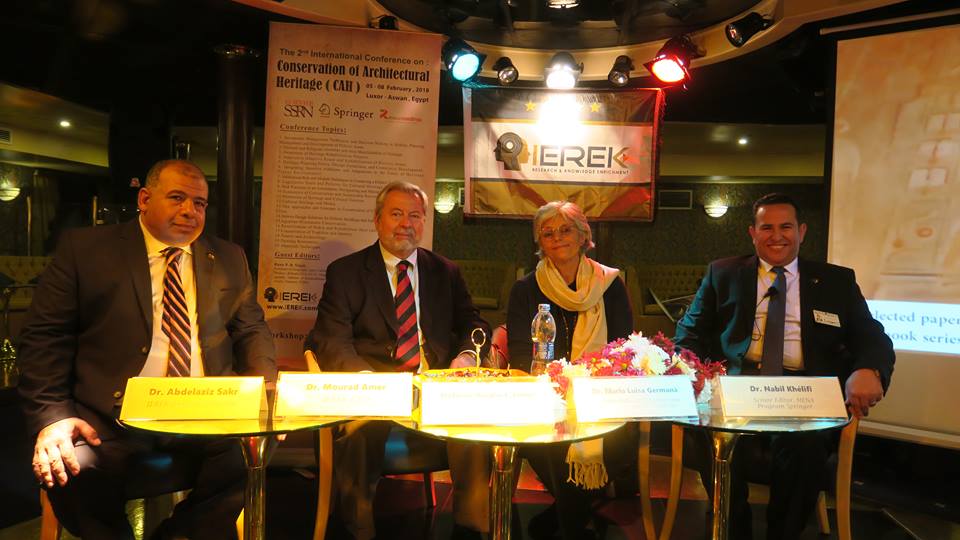
Check this conference’s overview here:
https://www.ierek.com/events/conservation-architectural-heritage-cah-2#overview
The 3rd International Conference on “Conservation of Architectural Heritage (CAH)” was held from on 19th to 22nd of February 2019 in association with Faculty of Engineering at Shoubra - Benha Unversity. The conference included many discussions, covered extremely important topics, and presented new scientific values in the scope of conserving the architectural heritage. For the third time, it was a very successful conference that cannot be forgotten.
The international conference was held in Aswan, Egypt, specifically at The Nubian Museum, which is considered to be a gateway to the history of Nubia and one of the most attractive touristic sites in Aswan.
This year, the conference was held under the patronage of Dr. Khaled Abdel Ghaffar (Minister of Higher Education and Scientific Research), Prof. Hussein El-Maghraby (President of Benha University), and The Supreme Council of Antiquities. It was also chaired by Prof. Ragab Megahed (Dean of Faculty of Engineering at Shoubra - Benha Unversity).
First Day: Opening Ceremony and Keynote Speeches
The opening ceremony started with greetings and short-introductions by:
Prof. Tarek Tawfik, General Director of the Grand Egyptian Museum
Prof. Ferdinando Trapani, Associate professor in Urban Planning, Università degli Studi di Palermo, Italy
Prof. Francesco Alberti, Associate professor of Urban planning and design at University of Florence, DIDA - Department of Architecture
Prof. Hussein El-Maghraby, President of Benha University
Dr. Abdel Moneim Saeed, General Director of Aswan and Nubian Antiquities
Dr. Ossama A.W Abd El Maguid, The Head Director of Nubia Museum
The opening ceremony witnessed highly-important speeches especially by the 2 Italian professors Ferdinando Trapani & Francesco Alberti who stressed on the necessity of collaboration and knowledge exchange between Egypt & Italy in the scope of conservation and preservation. The professors also presented the model of "conservation of heritage in Palermo" at the conference, which is considered a living example of exchanging knowledge between 2 great civilizations.
After the lunch break, authors (researchers) started to present a demo of their research paper in oral presentations while session chairman and moderators listen, discuss, and evaluate.
Second Day: The Parallel Sessions Continued & Start of the Workshop
Starting from the 2nd day, remaining authors (researchers) continued presenting their research papers while other participants (students) joined the accompanying workshop titled “Site Management of The Archaeological Sites”.
This workshop examined the interchangeable relationship between the archaeological sites and the historic monuments, and how they affect each other.
At the Nubian Museum, the workshop students obtained great lectures by well-known professors from the University of Benha, such as Prof. Khaled Abd El Hady, Prof. Mostafa Atalla, Prof. Amr Hanafy, Dr. Mona yehia, and Prof. Sadek Saad.
Third Day: Workshop Continued & Site Visit
The day started early with a tour visit to The Unfinished Obelisk (The largest known ancient obelisk and is located in the northern region of the stone quarries of ancient Egypt in Aswan), where a lecture was given by Prof. Khaled Abd El Hady, in addition to group work with participants.
Another tour visit to Temple of ISIS was also organized. Moreover, after lunch, the last visit was made to The Temple of Kom Ombo where all workshop participants enjoyed the scenes and gained a lot of knowledge about heritage in Egypt.
Fourth Day: Pin Up Presentation
At The Nubian Museum, many discussions and group work feedback have taken place regarding what they have seen and learned through this conference and accompanying workshop.
Finally, group photos of all conference participants were taken.
Check this conference’s overview here:




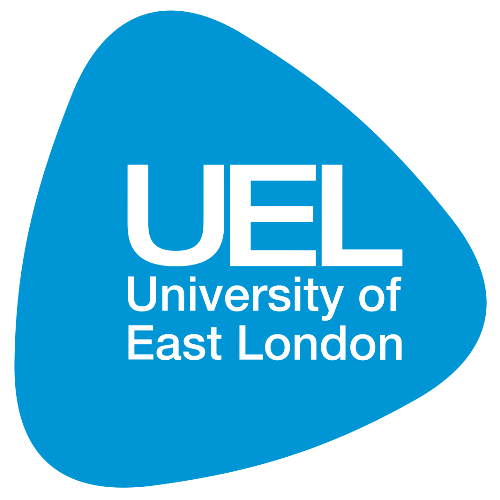











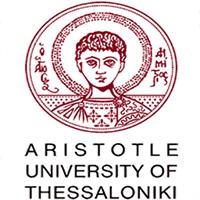
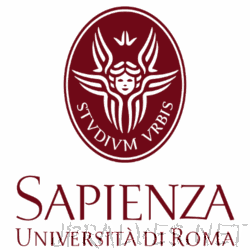
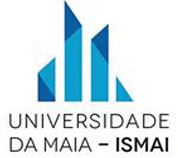


Prof. Stella Kostopoulou
Associate Professor of Regional and Tourism Development, Aristotle University of Thessaloniki (AUTh), Greece.
Antonella Versaci
Assistant professor at the Faculty of Engineering and Architecture, University "KORE", Enna, Italy.
Hocine Bougdah
Research and Education Consultant, IERS-UK / Visiting Lecturer, University of Westminster, London, UK.
Natsuko Akagawa
Senior Lecturer at the School of Languages and Cultures, Faculty of Humanities and Social Sciences, University of Queensland, Australia.
Subscribe to our newsletter
Join IEREK community